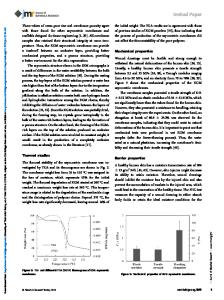Modified wound dressing with phyto-nanostructured coating to prevent staphylococcal and pseudomonal biofilm development
- PDF / 655,025 Bytes
- 8 Pages / 595.28 x 793.7 pts Page_size
- 23 Downloads / 318 Views
NANO EXPRESS
Open Access
Modified wound dressing with phytonanostructured coating to prevent staphylococcal and pseudomonal biofilm development Ion Anghel1,6, Alina Maria Holban2, Alexandru Mihai Grumezescu3*, Ecaterina Andronescu3, Anton Ficai3, Alina Georgiana Anghel4, Maria Maganu5, Veronica Lazǎr2 and Mariana Carmen Chifiriuc2
Abstract This paper reports a newly fabricated nanophyto-modified wound dressing with microbicidal and anti-adherence properties. Nanofluid-based magnetite doped with eugenol or limonene was used to fabricate modified wound dressings. Nanostructure coated materials were characterized by TEM, XRD, and FT-IR. For the quantitative measurement of biofilm-embedded microbial cells, a culture-based method for viable cell count was used. The optimized textile dressing samples proved to be more resistant to staphylococcal and pseudomonal colonization and biofilm formation compared to the uncoated controls. The functionalized surfaces for wound dressing seems to be a very useful tool for the prevention of wound microbial contamination on viable tissues. Keywords: Magnetite nanoparticles, Eugenol, Limonene, Wound dressing
Background Humans are natural hosts for many bacterial species that colonize the skin and mucosa as normal microbiota. However, in certain conditions, some microbes composing our microbiota generically called opportunistic pathogens can cause serious infections mainly by regulating their virulence [1,2]. Predisposing factors to cutaneous infections include minor trauma, pre-existing skin disease, poor hygiene, and, rarely, impaired host immunity [3]. Based on World Health Organization report in 2011, skin diseases still remain common in many rural communities in developing countries, with serious economic and social consequences, as well as health implications. As a form of adaptability and evolution, bacteria managed to establish a well-organized behavior into a very efficient assembly, called biofilm. Bacterial biofilm formation is the prevailing microbial lifestyle in natural and man-made environments and occurs on all surface types, including biological surfaces; it can be defined as a community of microorganisms irreversibly attached to a surface, * Correspondence: [email protected] 3 Department of Science and Engineering of Oxidic Materials and Nanomaterials, Faculty of Applied Chemistry and Materials Science, University Politehnica of Bucharest, Polizu Street No. 1-7, Bucharest 011061, Romania Full list of author information is available at the end of the article
producing extracellular polymeric substances, exhibiting an altered phenotype compared with corresponding planktonic cells, and interacting with each other [4,5]. One of the most significant clinical aspects is the fact that bacterial biofilms cause chronic infections because they disclose increased tolerance to antibiotics and disinfectants, as well as resisting phagocytosis and other components of the body’s defense system [6]. Approximately, 80% of all human infections are associated with biofilms, and ev
Data Loading...











